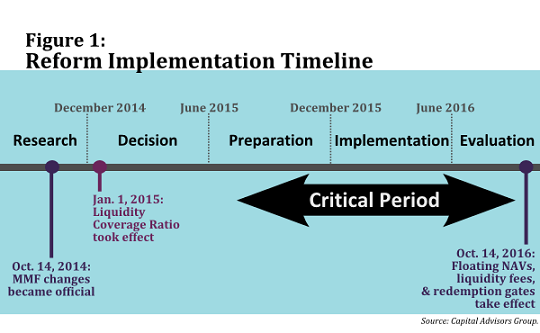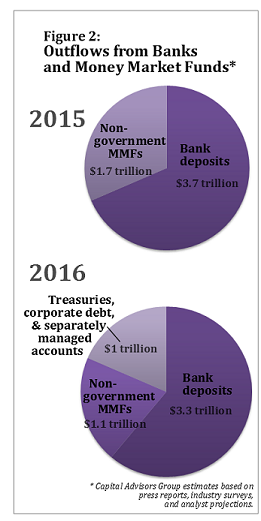 With interest rates poised to move higher in 2016, many treasury professionals are hoping for a return to the good old days of decent yields in safe investments for their corporate and institutional cash. However, the world they'll encounter when rates finally do rise will be very different from the higher-rate environment they left eight years ago.
With interest rates poised to move higher in 2016, many treasury professionals are hoping for a return to the good old days of decent yields in safe investments for their corporate and institutional cash. However, the world they'll encounter when rates finally do rise will be very different from the higher-rate environment they left eight years ago.
Since the financial crisis, the near-zero rates—combined with a lengthy period of guarantees on demand deposits—helped create a “business as usual” mind-set among many treasury professionals. But 2016 promises to be a pivotal year that will usher in a new era in cash management, requiring new ways of thinking.
Compared with a decade ago, today's cash investment landscape is shaped by higher risk awareness, more sensitivity to liquidity costs, and stricter systemic regulation. Dodd-Frank and Basel III are already causing the biggest banks to limit uninsured deposits. And when money market reforms are instituted in October 2016, institutional money funds will have less stability, greater risk, and lower yield potential.
Mindful of the timing and potential impact of these events (see Figure 1, below), treasury professionals have already started to position themselves for dramatic changes in the way they manage their short-term cash. Many are changing their written investment policies to accommodate more alternatives to traditional deposits and money market funds. At the same time, many are also upgrading their research and risk management capabilities to help safeguard principal and liquidity in a changing risk/return environment.
As they plan for 2016, treasury professionals will confront challenges on at least three fronts:
- While prime money market funds will still be available for cash management, their floating net asset values (NAVs) will change the utility they offer, and their new risk/reward equation will require close scrutiny.
- Supply of both traditional bank deposits and money market instruments may be constrained, requiring consideration of alternatives.
- Cash managers may feel compelled to venture into less-familiar territory with a new mix of traditional and non-traditional investments as they seek to deliver both liquidity and safety of principal.
By paying close attention to each of these challenges in the critical transition period early next year, treasury professionals will acquire tools to help maintain their desired mix of safety, liquidity, and yield throughout 2016 and beyond.
Staying Afloat with Floating NAV Money Funds
By the fall of 2016, when the dust has finally settled on money market reform, institutional prime money market funds will have adopted floating NAVs, and will have the option of imposing liquidity fees and redemption gates to limit investor withdrawals in times of stress. These dramatic structural changes, as prescribed by the 2014 rule amendment by the Securities and Exchange Commission (SEC), may fundamentally alter the desirability of money market funds as a cash management tool. But currently, little is known about what liquidity characteristics institutional prime funds will have in October 2016. No one knows exactly how institutional shareholders will accept the reformed prime money fund products, how effective liquidity-monitoring tools will be, or whether intraday liquidity will be possible.
The prospect of liquidity fees and redemption gates, in particular, are creating concern among corporate treasurers. If a fund doesn't restrict daily redemptions, liquidity could potentially evaporate quickly. For example, Treasury debt and agency debt that matures within 60 days is not cash in a literal sense. In a rising-interest-rate environment, a money fund selling these instruments to raise cash might inadvertently create realized losses, which could potentially lead to NAV erosion. NAV deterioration might encourage more redemption, exacerbating the liquidity shortage. Likewise, a few shareholders with a large concentration of shares might simultaneously decide to redeem shares from funds with low liquidity levels in periods of market volatility, resulting in a self-perpetuating liquidity drain. Shareholders in institutional funds that commingle pooled assets will need a comprehensive understanding of these and other liquidity risks in order to protect themselves.

Because of the liquidity risks, corporate cash managers will likely start to balance their portfolios with multiple liquidity instruments that complement one another. The portfolios will include the new institutional prime money funds with floating NAVs, but will not be limited to them. For example, a corporate portfolio might also include a government money fund with a stable NAV and direct purchases of government and other highly liquid securities. Government-fund shares may be used to accommodate unforeseen intraday liquidity needs, while institutional prime fund shares may provide extra yield potential and function as sources of next-day liquidity. Then a laddered portfolio of government and other securities may be used to provide backup liquidity through staggered maturities or open-market sales in the unlikely event that liquidity becomes inaccessible in prime funds.
Alternatives to Bank Deposits and Prime Money Funds
In 2016, regulations and market forces may reduce the availability and yields, and increase uncertainty about risk and liquidity, for both bank deposits and the new iteration of institutional money market funds. The net effect may be significant outflows from deposits and non-government prime money market funds. Capital Advisors Group estimates that more than $1 trillion in corporate cash which is currently held in bank deposits and money funds may migrate into new or different accounts in the coming year. Specifically:

- Reforms that strengthen banks' balance sheet liquidity have made traditional deposits more expensive and less available, leading large banks to reduce their proportion of uninsured deposits of corporate cash. Capital Advisors Group estimates that as much as $450 billion of the $3.7 trillion* held in overnight deposits at the top six global systemically important banks might move into safe but low-yield government securities and other vehicles.
- At the same time, with SEC-mandated changes in prime money funds increasing potential risk and reducing potential liquidity and yields, we estimate that as much as $615 billion of the $1.7 trillion in corporate cash held in institutional money funds will move into low-yield government funds and other vehicles (see Figure 2).
Most cash investment policies subscribe to the objectives of principal stability, liquidity, and income potential. Until recently, prime money market funds achieved all three objectives reasonably well, and bank deposits may have accomplished the first two. But if the hands-off liquidity management practice of leaving all cash balances in a few bank accounts or money market funds becomes less attractive from a risk-reward perspective, what are the alternatives?
An obvious destination for cash migrating from deposits and prime money funds is to government-only money market funds, which are not subject to floating NAVs, liquidity fees, or redemption gates. However, the influx of cash into this safe haven with a limited supply can be expected to depress yields. Evidence of this trend came in October 2015 with the first-ever sale of three-month Treasuries with a yield of zero.
Therefore, many corporate and institutional cash managers are considering supplemental alternatives to government securities, including direct purchases of short-term commercial paper and establishment of separately managed accounts. Direct purchases require hands-on investment and accounting expertise, liquidity management, and risk and credit monitoring. However, investing in research and counterparty risk management capabilities, and/or opting to employ separately managed liquidity accounts maintained by an advisory firm with appropriate expertise, can effectively address those issues.
Corporate treasurers wanting to change their cash-investment mix truly have a universe of options, each of which requires careful consideration. One of the largest factors impacting alternative investment strategies has been the contraction in supply of high-grade securities rated AA or higher (see Figure 3, below). Gone are the days when a treasurer could easily construct a cash portfolio solely with non-government AA and A-1+ credits. Today many investors are considering putting their cash to work in instruments with lower investment-grade ratings.
Those treasurers who can buy corporate bonds, either directly or through custom-tailored separate accounts, may benefit from a widening of spreads and increasing supply. Over the past decade, the dollar value of corporate bonds with an A rating as tracked in the Merrill Lynch 1-to-3-Year Corporate Index has increased almost fourfold, and supply of investment-grade BBB securities in the index has increased even more.
 Corporate bonds with BBB ratings have the positive attributes of broader supply, improved risk diversification, moderate default and ratings migration risk, and attractive yield potential. Of course, these attributes need to be viewed in the context of a treasury organization's investment policies for its general fixed-income portfolio, which tend to emphasize principal preservation and liquidity more than income.
Corporate bonds with BBB ratings have the positive attributes of broader supply, improved risk diversification, moderate default and ratings migration risk, and attractive yield potential. Of course, these attributes need to be viewed in the context of a treasury organization's investment policies for its general fixed-income portfolio, which tend to emphasize principal preservation and liquidity more than income.
Investors should expect lower market liquidity from BBB debt, and would be well-advised to use these investments only as part of a conservatively constructed core portfolio. But if one starts with a core base of high-quality liquid investments in a portfolio, BBB debt may be layered in as an attractive risk diversifier and yield enhancer.
In essence, as the short-term government securities continue to be haunted by supply constraints and stressed by demand, treasurers considering individual corporate securities or separately managed accounts should have adequate options.
The Right Investment Mix for Safety, Liquidity, and Yield
A key objective for many managers of institutional cash is to reduce unnecessary balances in overnight bank deposits and money market funds and to deploy cash in a diversified portfolio of high-quality instruments. Achieving the right balance of safety, liquidity, and yield becomes more challenging as the portfolio grows in complexity.
Cash investors constructing portfolios with a mix of deposits, money market funds, and direct investments often find that a stratified investment strategy works well. Dividing cash balances into specific categories and adopting different strategies for each helps treasurers achieve their liquidity and safety goals with appropriate returns. Many divide liquid balances into three segments according to liquidity volatility: daily, planned, and market (see Figure 4, below).
Daily liquidity. Maintaining sufficient balances for daily cash use and reserves for unanticipated fluctuations is necessary to ensure that the company can meet its daily liquidity requirements. Appropriate vehicles for holding this cash may include transactional bank deposits, stable-NAV money market funds and other pooled investments, and overnight repos.

Planned liquidity. For seasonal cash needs and planned expenditures, a liability-driven strategy with targeted maturities may provide higher income opportunity without sacrificing liquidity. Accounting rules may vary, but many such portfolios offer principal stability with “held to maturity” treatment. Appropriate instruments may include term deposit accounts, Treasury and agency securities, and high-quality corporate and financial credits.
Market liquidity. Sometimes referred to as “core cash” or “strategic balances,” market liquidity balances represent excess cash that isn't governed by near-term liquidity constraints. Less need for liquidity enables cash managers to employ more flexible strategies with the goal of maximizing return potential. In addition to proceeds that flow in as securities mature, liquidity may come from the secondary market. With a moderately longer time horizon, portfolio strategies may also include high-quality asset-backed and mortgage-backed securities.
Stratifying cash balances into several categories, and applying targeted strategies to each category, helps to delineate the three objectives of cash management: safety of principal, stability, and income potential. As it becomes increasingly difficult to deliver on all three objectives with deposits and money funds alone, a stratified approach may allow cash managers to pick the best strategies suited for each need, utilizing a combination of deposits, money market funds, and direct purchases in a comprehensive approach.
Managing Credit and Risk in the New Era
Managing risk through the upcoming period of market change will demand new levels of attention and caution from all stakeholders. Therefore, as cash investors in 2016 try to understand the newly constituted money market funds and examine a new mix of investment alternatives beyond bank deposits and money funds, they must also invest time and energy in comprehensive credit and risk management capabilities.
 Credit approval for a cash portfolio is different from the process used for other fixed-income investments. Cash investors have unique credit requirements, including liquidity needs, low thresholds for principal loss, a tendency to hold securities to maturity, and a conservative bias placing a higher priority on preservation of principal than on income. Another consideration is the available supply of suitable short-term investments.
Credit approval for a cash portfolio is different from the process used for other fixed-income investments. Cash investors have unique credit requirements, including liquidity needs, low thresholds for principal loss, a tendency to hold securities to maturity, and a conservative bias placing a higher priority on preservation of principal than on income. Another consideration is the available supply of suitable short-term investments.
Treasury professionals are advised to follow a rigorous protocol in selecting appropriate securities and then managing and monitoring the credit status of those securities. A comprehensive credit management program—including initial screening, macro screening, establishment of internal ratings, and ongoing monitoring and surveillance of the portfolio—is a start. The process should also entail mitigation of risk through development of plans for an effective response to, and management of, any credit event.
The stakes have never been higher for corporate treasury professionals, who will confront more dramatic changes in corporate cash management in 2016 than they have in years. The good news is that with the right preparations, including a renewed focus on credit and risk management and consideration of alternative investments, they will have the tools they need to succeed.
—————————————
 Ben Campbell is founder and CEO of Capital Advisors Group, Inc., an independent investment advisor based in Newton, Massachusetts, that specializes in institutional cash investments, risk management, and debt financing. In June 2011, Treasury & Risk named Ben one of the “100 Most Influential People in Finance.”
Ben Campbell is founder and CEO of Capital Advisors Group, Inc., an independent investment advisor based in Newton, Massachusetts, that specializes in institutional cash investments, risk management, and debt financing. In June 2011, Treasury & Risk named Ben one of the “100 Most Influential People in Finance.”
 Lance Pan, CFA, is the director of investment research and strategy for Capital Advisors Group.
Lance Pan, CFA, is the director of investment research and strategy for Capital Advisors Group.
© 2025 ALM Global, LLC, All Rights Reserved. Request academic re-use from www.copyright.com. All other uses, submit a request to [email protected]. For more information visit Asset & Logo Licensing.




